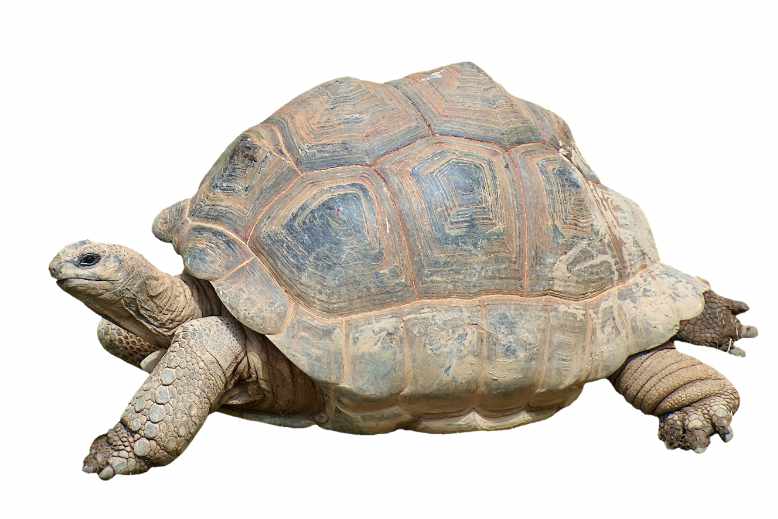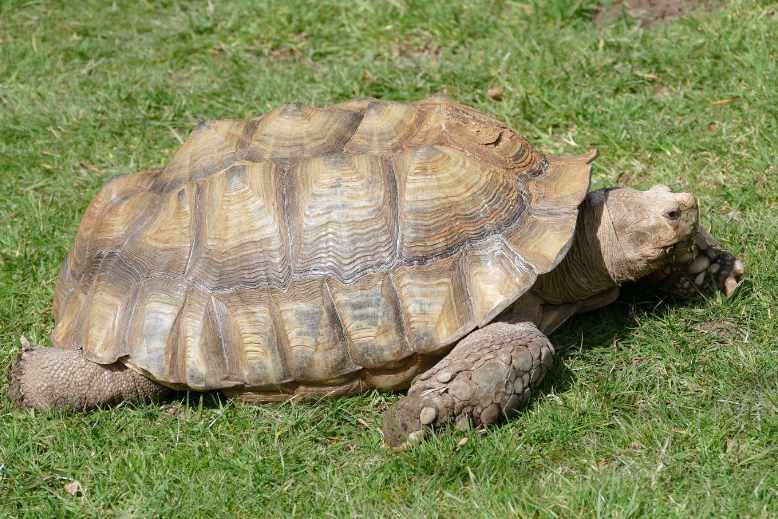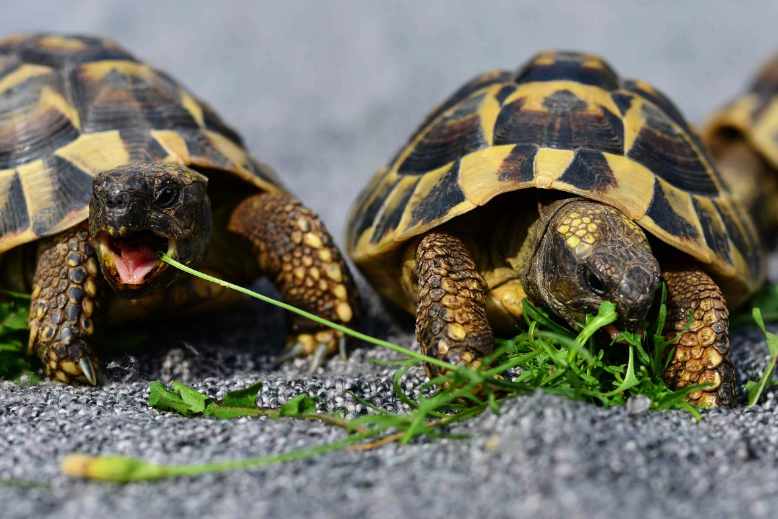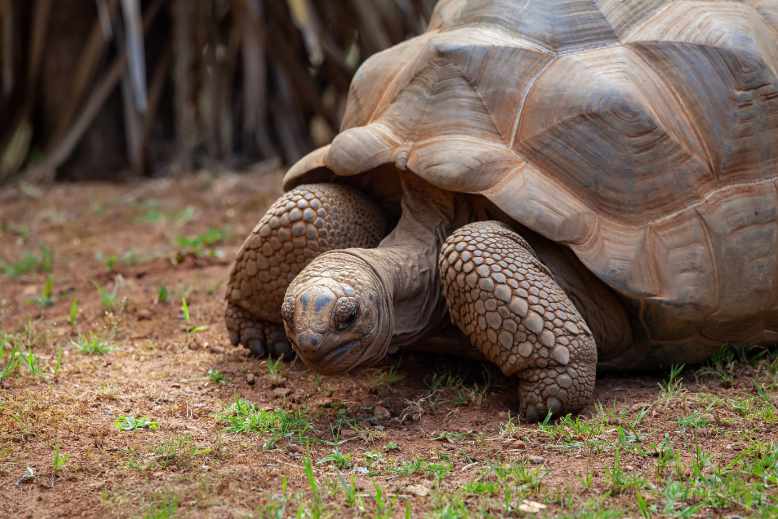The early signs of pyramiding in tortoises include the vertical growth of individual scutes and abnormal overgrowth of the shell. Scutes are the polygonal-shaped plates or individual segments that make up a tortoise’s shell. In a healthy and normally developing tortoiseshell, these polygonal scutes form a smooth dome-like shell. However, in the case of pyramiding, the individual scutes tend to grow vertically, creating a series of irregular bumps, or in other words, pyramids (which explains the name of this shell condition). The shell deformation can be either critical or minor.
Whether you have a cute little tortoise as a pet or not, the chances are high that you may have seen a tortoise “dealing” with pyramiding (we are not using the word suffering because it isn’t the right term to describe this condition, why? Will discuss in a while!) This shell deformation is seldom seen in wild tortoises but is pretty common in captive-hatched ones. Pyramiding usually does not make the tortoiseshell hurt. However, if it results from some dietary deficiency, it may lead to specific health concerns.
In today’s article, we will discuss what makes a dome-like shell pyramid, what health risks are associated with this particular condition, how we can rescue our lovely tortoise from overgrowing shells, and if there is anything we should concern about.
Read on for pointer to find out all about it.
Early signs of pyramiding in tortoises

Shell pyramiding is the most common issue that turtle and tortoise keepers have to deal with. This condition makes the shell look deformed and causes excessive upward growth of individual scutes. The excessive growth looks like a pyramid on the outer part of the tortoise’s shell or carapace. Pyramiding necessarily doesn’t hurt and is usually caused by improper care. However, it looks unnatural and comes with multiple health concerns.
A healthy tortoiseshell is supposed to grow horizontally. But when the tortoise doesn’t have access to a proper diet or adequate housing requirements, their natural shell growth switches from horizontal to vertical, creating a bumpy and unappealing tortoiseshell. The early signs of pyramiding in tortoises include vertical and not-so-smooth shell growth. Both turtles and tortoises experience this disease. It is an outcome of poor husbandry routine and some other contributing factors.
You can easily identify and diagnose this problem by looking at the apparent pyramid-like deformation of the shell. It is not common in the tortoises living in the wild, but that doesn’t mean wild ones have a perfect existence. Living in the wild and foraging for food isn’t that easy after all.
Is tortoise pyramiding life-threatening?
Pyramiding is a kind of metabolic bone disease or, for short, MBD. In this condition, the top scutes of the tortoiseshell start to grow in a vertical direction instead of a horizontal direction. The top and bottom shells (Carapace and Plastron) become extremely short and soft in extreme conditions.
Although young and Juvenile tortoises have soft bottom shells, these shells harden with age. But with severe pyramiding, shells don’t harden with time which is harmful as tortoises need hard shells to protect their insides.
Pyramiding is not a normal shell development process. It usually occurs during a tortoise’s active growth period. This condition significantly affects the mobility of a tortoise. Extreme pyramiding can reduce the ability of a male tortoise to mount its female counterpart, thus hindering the process of mating/ reproduction.
Except for some severe cases, pyramiding is not life-threatening. But excessive growth can lead to some other pathological consequences as well. Some of the most common health concerns are:
- Gastrointestinal problems
- Obesity
- Reduced mobility
- High mortality
- Renal diseases
- Metabolic bone disease
Once you notice your tortoise has a bumpy shell, check its diet and enclosure to understand what’s wrong. Only then can you take the necessary steps to stop pyramiding in your tortoise.
Causes of shell pyramiding in tortoises

Well, it is hard to point out a single clear-cut cause of pyramiding in tortoises. No one really knows the reason behind it. Some experts believe that locale, origin, and genetics alter the natural shell shape by turning it into a deform and bumpy shell.
Malnutrition has a vital role in the development of uneven and irregular shells. Although its underlying cause is a mystery, the excess amount of protein in your tortoise’s diet appears to be a major factor.
The protein requirements of tortoises reduce as they grow. Their ideal food source is a combination of multiple green vegetables. Greens will provide them just the right amount of calcium.
Many experts believe that the following factors cause pyramiding:
- Not getting the first few years right
It appears that pyramiding usually develops during the first one or two years of a tortoise’s life. The way a fast-growing tortoise lives during this time has a significant impact on shell development. If the tortoise is not raised well in its early years, stacks of keratin build up in the scutes, forming an irregular appearance. In some advanced cases, the shell flattens out.
It is significant to ensure that you are buying a tortoise from a reputable tortoise breeder. Reputable breeders are responsible for the overall care and health of your lovely tortoise up to the point of purchase. If for any reason, the tortoise couldn’t get the early years right, you will have to deal with numerous health conditions further down the line.
- Low humidity
Low humidity can lead to the development of pyramiding in Mediterranean and desert tortoise species. The theory is that a tortoise’s shell tends to grow excessively to reduce the loss of water through evaporation in an extremely dry environment.
Maintaining the optimal humidity level can be challenging as most tortoises aren’t indoor pets. Plus, not two tortoises have similar humidity needs.
Low humidity is a serious concern if you live in an area where the humidity levels remain lower than 60% most of the time, and your pet tortoise is an outdoor pet.
The ideal humidity level for an adult tortoise is at least 60%. For juveniles and hatchlings, the humidity level of 65% is just right. Now we are not advocating constant humidity in your tortoise vivarium as it can result in other health concerns such as shell root. But a few sprays from a water bottle every day, 10-minute water soaking twice a week, and all-time access to drinking and bathing water are sufficient to meet the humidity needs of your tortoise.
- Incorrect substrate
This is probably the most contentious subject amongst tortoise owners and breeders. Knowing which substrate is right for your tortoise is not less than black art. The right substrate maintains the humidity level while more moist substrates serve as a breeding ground for fungus and other harmful bacteria.
Drier substrates are often too dusty, leading to respiratory issues. It also gives rise to pyramiding issues.
- Too much protein in the diet

We agree. Protein being the building block of growth and development is vital for your pet. However, unnecessarily high protein levels can cause excessive levels of growth. Extravagant levels of protein in your cold-blooded pet’s diet force the scutes to grow upward.
Tortoises do not require an extreme amount of protein in their everyday diet. The protein levels available in the greens and weeds are more than sufficient to meet your tortoise’s protein needs.
Red foot tortoise requires a slightly greater amount of protein. But you can easily meet their protein requirements with an occasional worm and mouse. A big mistake that most red foot tortoise owners make is that they try to raise their tortoise on dog and cat food which, considering the risk of pyramiding, is a big no-no.
- Imbalance diet
Another big fat reason for tortoiseshell pyramiding is poor dietary habits. Many naive tortoise keepers tend to feed high protein and fat diets to their tortoise. Some keepers even overfeed.
All these factors can lead to shell pyramiding.
- Lack of exercise
Lack of exercise is a potential cause of shell pyramiding in turtles and tortoises. Inactivity is common amongst indoor tortoises. Some reptile owners use tiny enclosures for cold-blooded pets that don’t promote exercise, thus causing bumpy and ugly-looking shells.
Tiny water tanks are not something we would recommend for tortoises. An ideal tortoise enclosure should be large enough for the pet to roam around easily. Tortoise owners should provide several decorations and accessories, such as fake plants, rocks, etc., to entice the tortoise so the little fellow can come out and investigate.
- Incorrect levels of dietary minerals heat and UV light
Tortoises need heat to carry out their metabolic functions. And heat lamps are vital for maintaining the temperatures and heat requirements of tortoises. However, heat lamps can prove harmful if the environment is extremely dry. These lamps cause the tortoise to lose more water in a too dry climate, eventually drying out their shell. This water loss can lead to pyramiding.
You can tackle this problem by slightly increasing the humidity levels of your enclosure.
Tortoises use UV-B light to synthesize vitamin D3. It helps them in their bone and shell development. Lack of vitamin D3 can lead to shell pyramiding and metabolic bone diseases. So, make sure your tortoise has sufficient access to UV-B light.
With adequate calcium, minerals, and UV light arrangement, you can stop shell deformities.
Some other factors contributing to pyramiding are:
- Excessive protein
- Extreme phosphorus levels
- Less exposure to sunlight
- Overfeeding and overeating
- Poor humidity levels
- Dehydration
- Inadequate dietary fiber
- Excessive oxalate in the diet
- Insufficient vitamin D3
- Grain-based diets
How to prevent pyramiding in tortoises

As soon as you notice the early signs of pyramiding in tortoises, change the living environment and diet of your pet. If the scutes are already pyramiding, there is nothing you can do to reverse it. However, you can instead put a stop to future pyramiding.
By monitoring your pet’s housing and dietary limitations, you can successfully prevent scutes’ abnormal and vertical growth.
Before going any further, make sure:
- The tortoise is not overfed.
- Your tortoise receives proper humidity and has access to clean drinking and bathing water.
- The pet has exposure to sunlight and has enough time to exercise.
Other than that, here are some steps that you can take to prevent the early signs of pyramiding in tortoises:
- Maintain the Hydration levels
A recent study has revealed that turtles and tortoises kept in high hydration and humidity levels experience less pyramiding. Hydration not only promotes healthy and bump-free horizontal shell growth but also keeps some other health concerns at bay.
- Promote sun exposure
An adequate amount of sun exposure and a wide space for roaming are the best strategies to prevent pyramiding in tortoises. Therefore, we encourage reptile lovers to take their tortoises out for healthy sun exposures. Just beware of the predators eyeing your lovely pet.
- Exercise your tortoise
Exercise elevates the chances of healthy shell growth. To encourage your pets to exercise more, you can plant more edible flowers, weeds, and green grasses in their tank. It is also recommended to opt for a bigger tank and provide a clean pool of water.
- Use a good quality substrate.
The best ground cover that you can choose is Cyprus mulch and grass. Both of these substrates are great at retaining humidity. If your turtle lives in an outdoor enclosure, water it more. Don’t mind hosing down your tortoise as well. If your tortoise is an inside pet, spray bottles are a better option to maintain the humidity levels.
Bottom Line
Tortoise pyramiding is not a simple problem that you can avoid. It is a serious health concern that requires your immediate attention and care. Owners are suggested to resolve this issue as soon as they notice the early signs of pyramiding in tortoises.
Hopefully, our tips will help you ensure the overall health of your cold-blooded pet. We encourage you to follow these steps so your tortoise can have a good chance at a healthy life.
